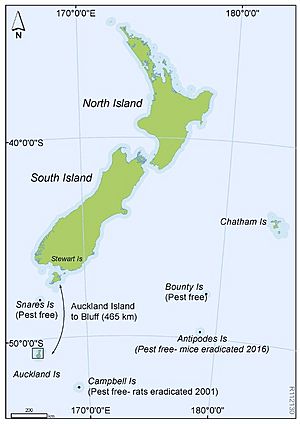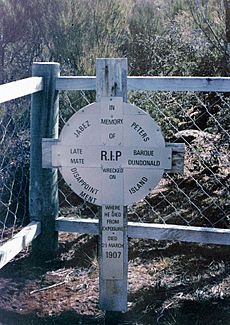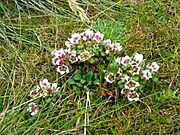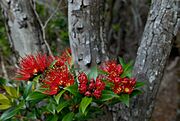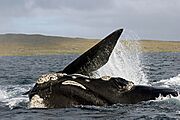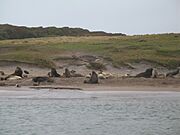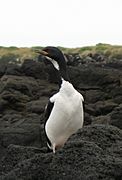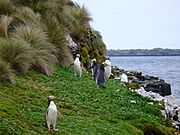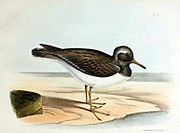Auckland Islands facts for kids
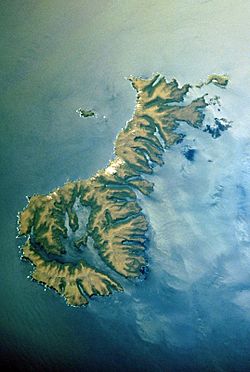
The Auckland Islands as seen by STS-89 in 1998, with the northwest towards the top of the image
|
|
|
Map of the Auckland Islands
|
|
| Geography | |
| Location | Southern Pacific Ocean |
| Coordinates | 50°42′S 166°06′E / 50.7°S 166.1°E |
| Archipelago | Auckland Islands |
| Total islands | 31+ |
| Major islands | Auckland Island, Adams Island, Enderby Island, Disappointment Island, Ewing Island, Dundas Island, Green Island |
| Area | 570 km2 (220 sq mi) |
| Highest elevation | 705 m (2,313 ft) |
| Highest point | Mount Dick |
| Administration | |
| Area Outside Territorial Authority | New Zealand Subantarctic Islands |
| Demographics | |
| Population | 0 (2015) |
The Auckland Islands are a group of islands that belong to New Zealand. They are located about 465 kilometers (289 miles) south of New Zealand's South Island. In the Māori language, they are called Motu Maha, which means "Many islands", or Maungahuka, meaning "Snowy mountains".
The main island is called Auckland Island. It covers about 460 square kilometers (178 square miles). Around it are smaller islands like Adams Island, Enderby Island, Disappointment Island, Ewing Island, Rose Island, Dundas Island, and Green Island. All the islands together cover about 570 square kilometers (220 square miles). No people live on the islands permanently.
The Auckland Islands are part of the New Zealand Outlying Islands. They are directly part of New Zealand, but they don't belong to any specific region or district. Instead, they are considered an "Area Outside Territorial Authority." This is similar to most other outlying islands, except for the Solander Islands.
These islands are very important for nature. They are part of the Antipodes Subantarctic Islands tundra ecoregion. In 1998, the Auckland Islands and other New Zealand Subantarctic Islands were named a UNESCO World Heritage Site. This means they are protected because of their special natural value.
Contents
Exploring the Geography of the Auckland Islands
The Auckland Islands are located far south in the Pacific Ocean. They are about 360 kilometers (224 miles) south of Stewart Island. The islands are found between 50° 30' and 50° 55' South latitude and 165° 50' and 166° 20' East longitude.
The group includes Auckland Island, Adams Island, Enderby Island, Disappointment Island, Ewing Island, Rose Island, Dundas Island, and Green Island. These islands are quite close to each other, with narrow channels separating them. The coastlines are rough, with many deep bays and inlets.
Auckland Island is the largest island. It is about 42 kilometers (26 miles) long and covers about 510 square kilometers (197 square miles). It has very steep cliffs and rocky land, with mountains rising over 600 meters (2,000 feet) high. Some tall peaks include Cavern Peak (659 meters or 2,162 feet) and Mount Raynal (635 meters or 2,083 feet).
At the southern end of Auckland Island, a narrow channel called Carnley Harbour separates it from Adams Island. Adams Island is shaped like a triangle and is even more mountainous. Its highest point is Mount Dick, which is 705 meters (2,313 feet) tall. Carnley Harbour is actually what's left of an old volcano crater. Adams Island and the southern part of the main island form the rim of this ancient crater.
The group also has many other smaller islands. Two notable ones are Disappointment Island, which is northwest of the main island, and Enderby Island, located off the northern tip of the main island. Together, these smaller islands cover about 12 square kilometers (4.6 square miles).
Most of the islands were formed by volcanoes. The main islands are parts of two large shield volcanoes that formed about 12 million years ago. Over time, these volcanoes have been worn down by weather. Underneath these younger volcanic rocks are older ones, some as old as 15 to 25 million years. There are also even older granite rocks and sedimentary rocks with fossils from about 100 million years ago.
Named Islands of the Auckland Group
Here is a list of the named islands in the Auckland group, along with their sizes:
| Location | Area (hectares) |
||
|---|---|---|---|
| Auckland Island | 45,916.6 | ||
| Adams Island | 9,695.8 | ||
| Enderby Island | 695.9 | ||
| Disappointment Island | 289.5 | ||
| Rose Island | 80.2 | ||
| Ewing Island | 58.3 | ||
| Ocean Island | 11.9 | ||
| Detached Rock | 7.5 | ||
| Adams Rocks | 7.5 | ||
| Masked Island | 5.7 | ||
| Figure of Eight Island | 5.3 | ||
| Column Rocks | 5.2 | ||
| Dundas Island | 4.9 | ||
| Sugar Loaf Rocks | 4.8 | ||
| Monumental Island | 4.3 | ||
| Lantern Rocks | 3.9 | ||
| Green Island | 3.0 | ||
| Compadre Rock | 2.8 | ||
| Frenchs Island | 1.9 | ||
| Five Sisters Rocks | 1.9 | ||
| Yule Island | 1.6 | ||
| Friday Island | 1.6 | ||
| Pinnacle Rocks | 1.5 | ||
| Pillar Rock | 1.2 | ||
| Blanche Rock | 1.0 | ||
| Amherst Rock | 0.8 | ||
| Shag Rock | 0.5 | ||
| Beehive Rock | 0.4 | ||
| Beacon Rock | 0.3 | ||
| Davis Island | 0.1 | ||
| Archer Rock | 0.1 |
|
56,816.1 |
What is the Climate Like?
The Auckland Islands have a subpolar oceanic climate. This means the weather is often cloudy, and it's never too hot or too cold. It's usually cool and wet all year round.
The climate is very similar to what you would find in places like the Faroe Islands or the Aleutian Islands.
A Look at the History of the Auckland Islands
How Were the Islands Discovered?
It is believed that Polynesian voyagers were the first to discover the Auckland Islands. Archaeologists have found signs of Polynesian settlement on Enderby Island, possibly from the 13th century. This is the southernmost Polynesian settlement ever found.
Later, in 1806, a whaler ship named Ocean discovered the islands. They were uninhabited at the time. Captain Abraham Bristow named them "Lord Auckland's" on August 18, 1806. He did this to honor his father's friend, William Eden, 1st Baron Auckland. Bristow worked for a businessman named Samuel Enderby, who gave his name to Enderby Island. The next year, Bristow returned to claim the islands for Britain. Explorers like Dumont D'Urville and James Clark Ross also visited in 1839 and 1840.
Whalers and seal hunters set up temporary camps on the islands. For a while, the islands were one of the most important places for sealing in the Pacific. But by 1812, so many seals had been killed that the islands were no longer important for hunting. Sealers then moved to other islands. However, in the mid-1820s, seal populations grew back a bit, allowing some sealing to restart. The sealing era lasted from 1807 to 1894. During this time, 82 ships visited for sealing, and 11 of them were wrecked. You can still find old inscriptions, hut remains, and graves from this time.
Attempts at Settlement
The islands are now uninhabited, but there were attempts to settle them in the mid-1800s. In 1842, about 70 Māori and their Moriori slaves from the Chatham Islands moved to the archipelago. They lived there for about 20 years by sealing and growing New Zealand flax.
In 1846, Samuel Enderby's grandson, Charles Enderby, suggested building a community based on farming and whaling. This settlement, called Hardwicke, was started at Port Ross in 1849. But it only lasted for two and a half years. Māori and Moriori people continued to live there until 1866. Most of the Māori and some Moriori returned to the Chatham Islands. However, most of the Moriori settled on Rakiura, where their descendants still live today.
The Auckland Islands became part of the Colony of New Zealand in 1842. They were briefly excluded in 1846 but were included again in 1863 by an act of the British Parliament.
Famous Shipwrecks
The Auckland Islands have a history of shipwrecks due to their remote and rugged nature.
- In 1864, the ship Grafton, captained by Thomas Musgrave, was wrecked in Carnley Harbour.
- A few months later in 1864, the Scottish ship Invercauld was also wrecked there.
- In 1866, one of New Zealand's most famous shipwrecks happened on the western coast: the General Grant. Ten survivors lived on Auckland Island for 18 months before being rescued. People have tried many times to find its cargo, which is said to include gold, but they have not succeeded.
Because of these wrecks, people asked for emergency supply depots to be set up on the islands in 1868. The New Zealand government created and maintained three such depots at Port Ross, Norman Inlet, and Carnley Harbour starting in 1887. They also left extra supplies, like boats and finger-posts with small amounts of supplies, around the islands.
Another sad event happened in 1907 when the ship Dundonald was lost off Disappointment Island, and 12 crew members died. The 15 survivors were able to live off the supplies from the Auckland Island depot.
More recently, in 2019, a helicopter with three people crashed into the ocean near Enderby Island. They were on their way to pick up a sick man from a fishing boat. All three passengers survived the crash and were found the next day with only minor injuries.
Scientific Research and Protection
Several scientific groups visited the Auckland Islands in 1840. These included the United States Wilkes Expedition, d'Urville's French voyage, and the British Ross expedition.
In 1907, the Sub-Antarctic Islands Scientific Expedition from New Zealand spent two weeks on the islands. They studied the magnetic field and collected plant, animal, and rock samples.
From 1941 to 1945, during World War II, a New Zealand weather station was set up on the islands. This was part of a secret coastwatching program called the "Cape Expedition". The staff, who were volunteer scientists, also studied the plants and animals and collected scientific samples.
Today, the islands have no permanent residents. However, scientists visit regularly, and a small number of tourists are allowed on Enderby Island and Auckland Island.
In 1993, the ocean around the islands became a marine mammal sanctuary. In 2003, it also became a marine reserve, covering about 4,980 square kilometers (1,923 square miles). The marine reserves around the Auckland, Antipodes, Bounty, and Campbell Islands together form the largest natural protected area in New Zealand.
The Amazing Ecology of the Auckland Islands
Unique Plants
The plants of the Auckland Islands were first described in a book called Flora of Lord Auckland and Campbell's Islands in the 1840s. Since then, many other scientists have studied the plants. There are 228 types of vascular plants (plants with tubes for water and nutrients), and more than 80% of them are native to the islands. About 20% were brought in by people.
The plants grow in different zones based on how high they are. Near the coast, where there is salt spray, you'll find forests of southern rātā trees (Metrosideros umbellata). In some places, there are also subantarctic tree daisies (Olearia lyallii), which were probably brought by sealers. Higher up, there's a shrub zone with plants like Dracophyllum, Coprosma, and Myrsine. Even higher, you'll see tussock grass and megaherb plants, which have very large leaves and flowers.
-
Gentianella concinna, a plant found only on the Auckland Islands.
Tiny Creatures: Invertebrates
The islands are home to the largest groups of subantarctic invertebrates (animals without backbones). This includes 24 types of spiders, 11 types of springtails, and over 200 types of insects. Among the insects, there are 57 kinds of beetles, 110 kinds of flies, and 39 kinds of moths. The islands also have a special kind of wētā (a large cricket-like insect) called Dendroplectron aucklandensis, which is found nowhere else.
Life in Fresh and Saltwater
The freshwater on the islands has a fish called the kōaro, or climbing galaxias. This fish lives in saltwater when it's young but returns to the rivers as an adult. There are also 19 types of freshwater invertebrates found only on these islands. These include a mollusc, a crustacean, a mayfly, 12 types of flies, and two types of caddisflies. The Auckland Islands cockle is a type of shellfish unique to these islands.
Amazing Marine Mammals
Two types of seals often come ashore on the islands: the New Zealand fur seal and the New Zealand sea lion, which is a threatened species. Southern elephant seals visit often in winter, and leopard seals sometimes appear too.
More than 2,000 southern right whales are found near the islands, and their numbers are growing. The Port Ross area is considered the most important place for whales to gather in New Zealand waters. It's even more important than the area around Campbell Island.
-
Southern right whales playing in Port Ross.
-
By the 21st century, the islands became the main breeding spot for New Zealand sea lions.
Incredible Birds
The islands are very important breeding grounds for many seabirds. These include albatrosses, penguins, and several small petrels. There are even a million pairs of sooty shearwaters! Landbirds include red-fronted and yellow-crowned parakeets, New Zealand falcons, tūīs, bellbirds, pipits, and a special type of tomtit found only here.
The entire Auckland Island group is recognized as an Important Bird Area (IBA) by BirdLife International. This is because it's a vital breeding place for many seabirds and has eight types of birds or subspecies found nowhere else. These include the Auckland shag, Auckland teal, Auckland rail, Auckland snipe, Gibson's albatross, Auckland Island banded dotterel, and the Auckland Island tomtit. Sadly, the Auckland Island merganser is now extinct. Other seabirds found here include southern rockhopper and yellow-eyed penguins, and several types of albatrosses.
-
The extinct New Zealand merganser
-
The locally extinct shore plover
Protecting the Environment
Over time, several introduced species (animals brought by humans) have arrived on the islands. Goats, other useful animals, and seeds were brought by captains in 1865 to help castaways. In the 1990s, scientists removed or allowed to die out animals like cattle, sheep, goats, dogs, possums, and rabbits. However, feral cats, pigs, and mice are still on Auckland Island. The last rabbits on Enderby Island were removed in 1993 using poison, which also got rid of mice there. Interestingly, rats have never made it to the islands, even with many ship visits and wrecks.
These introduced species have caused a lot of harm to the island's natural habitats and ecosystems. They have damaged plants and reduced or wiped out bird populations on many islands. For example, they caused the extinction of the New Zealand merganser, a type of duck that used to live all over southern New Zealand.
The New Zealand Department of Conservation (DOC) plans to remove the remaining introduced mammals from Auckland Island. If successful, this would make the entire island group free of pests. This project began in November 2018 and could cost a lot of money over 10 years.
Animals Found Only on the Auckland Islands
- Auckland Island wētā (Dendroplectron aucklandensis)
- Auckland Islands cockle (Austrovenus aucklandica)
- Auckland rail (Lewinia muelleri)
- Auckland snipe (Coenocorypha aucklandica aucklandica)
- Auckland teal (Anas aucklandica)
- Auckland shag (Leucocarbo colensoi)
- Auckland Island merganser (Mergus australis) - extinct
- Auckland Island tomtit (Petroica macrocephala marrineri)
- Auckland Island banded dotterel (Charadrius bicinctus exilis)
- Gibson's albatross (Diomedea antipodensis gibsoni)
Plants Found Only on the Auckland Islands
- Azorella schizeilema
- Callitriche aucklandica
- Cardamine depressa subsp. depressa
- Cardamine latior
- Dracophyllum cockayneanum
- Gentianella cerina
- Gentianella concinna
- Geum albiflorum
- Plantago aucklandica
- Poa aucklandica subsp. aucklandica
How the Islands Are Protected
The Auckland Islands, like all of New Zealand's subantarctic islands, are a National Nature Reserve. This means they have the highest level of protection under New Zealand law. Also, a marine reserve covers all the ocean around the Auckland Islands and its inner waterways.
The Department of Conservation (DOC) manages all of New Zealand's subantarctic islands. They keep the number of visitors and the length of stays very low. You need a special permit to visit, and all applicants must go through strict checks to make sure they don't bring any harmful plants or animals to the islands.
When Andrew Fagan sailed to the islands alone in his 5.4-meter (18-foot) plywood yacht, he described the DOC permit process. He said that the islands are very special and protected, so to visit them, you have to be special too. Even his boat had to be inspected by divers to make sure no unwanted seaweeds were clinging to it, which could harm the island's environment.
See also
 In Spanish: Islas Auckland para niños
In Spanish: Islas Auckland para niños


